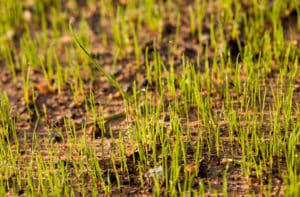Watering
This may be the most important step. With the first watering, make sure that you apply enough water to wet the soil down to at least 6 to 8 inches. Apply the water gently so that you don’t wash the seed away or create puddles.
You may have to water several times in short intervals until the bed is thoroughly wet. After that, water often enough to keep the top inch or so of the seedbed moist until the seed germinates. Remember, seeds get only one shot at germination. If you let them dry out, they will die.
Sprinkle the seedbed lightly with a handheld hose several times a day — especially if it’s hot or windy — to get even germination across the entire lawn. However, you don’t want to overdo it. Too much water causes the seed to rot.
Watch the color of the soil surface. As the soil dries, the surface becomes lighter in color. When you notice about half to two-thirds of the surface lightening up, it’s about time to water.
Caring for your new lawn after germination
 As your new lawn becomes established, you can start easing up on the water, depending on the weather. If you continue your everyday watering routine, you’re likely to overdo it and rot the young seedlings. Also, if the ground is too wet, you can inhibit root growth.
As your new lawn becomes established, you can start easing up on the water, depending on the weather. If you continue your everyday watering routine, you’re likely to overdo it and rot the young seedlings. Also, if the ground is too wet, you can inhibit root growth.
When you have a pretty even ground cover of new seedlings, try skipping a day of watering and see what happens. Watch the grass carefully. If the color starts to go from bright green to dull gray green, the grass needs water. You may have to water some quick-to-dry areas with a handheld hose.
If the grass doesn’t dry out, keep stretching the intervals between watering until you’re on a schedule of once or twice a week, or as needed. When you do water, don’t forget to water deeply, getting the moisture down 6 to 8 inches.
Mowing and fertilizing
You will need to mow the new lawn when it reaches 3 to 4 inches high, depending on the type of grass. Mow when the soil is on the dry side; otherwise, you might tear up the new turf. Make sure not to have your mower set too low. It is always good to mow grass at 3 inches or higher to prevent it from drying out. This is especially true for your new lawn.
You also need to make your first application of fertilizer about 4 to 6 weeks after germination. Young seedlings have a hefty appetite, so don’t skip this important feeding. It is very typical to have broadleaf weeds pop up in newly seeded areas. Whether it’s new soil or freshly cultivated soil, it is a prime target for blowing weed seeds to find a home. Don’t worry too much about the weeds until the grass is about 8-10 weeks established. After that you can apply a weed and feed fertilizer or a systemic spray to take care of the broad leaf weeds. Regular weed control and fertilizer applications as needed are recommended for a nice healthy lawn.
